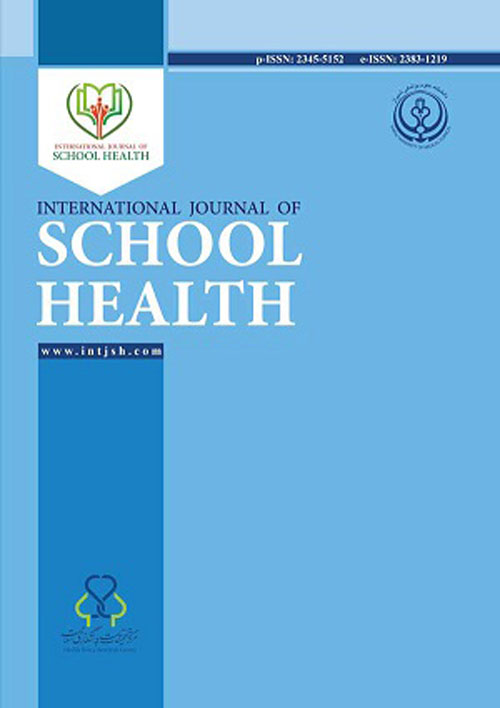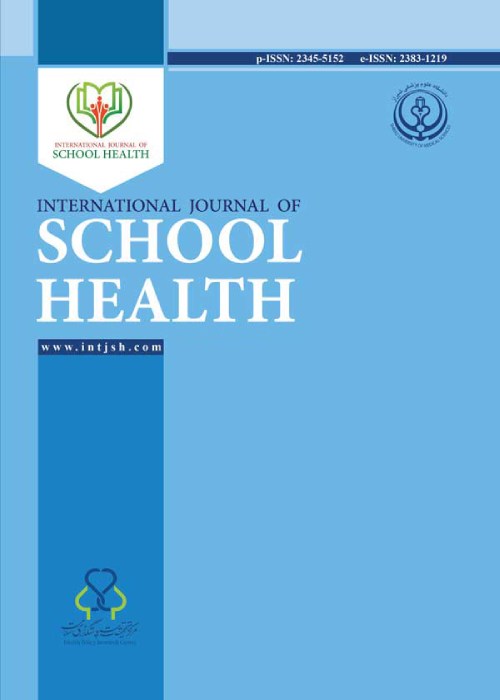فهرست مطالب

International Journal of School Health
Volume:1 Issue: 2, Summer 2014
- تاریخ انتشار: 1393/07/18
- تعداد عناوین: 7
-
-
Page 1BackgroundThe main goal of sending children to school is to educate and teach them ethical conducts. But do they learn social behaviors out in these schools? Most of students after Entring School and facing new environment and not being monitored by their observant parents become exposed to antisocial behaviors and learn them from their peers. This trend is intensified and hard to control by forming peer groups..Evidence Acquisition: The information and data gathered from library and internet searches. Most articles were searched via sciencedirect.com search engine. Keywords used to access hundreds of papers included antisocial behavior, school and crime, peer groups, age and crime, crime prevention, aggression and violence. The most related articles were selected after consulting and thoroughly reading the downloaded articles. Many articles were excluded owing to their simplistic content and repetitive information..ResultsMounting evidence indicates that schooling can have large amount of unexpected negative effect on pupils. Students learn antisocial behavior from other students and sometimes from their own teachers. Perhaps remarkably, children’s biological changes could manifestly affect their behaviors and turn them into aggressive characters..ConclusionsTo date, hundreds of researches have been carried out in order to identify antisocial behavior in schools. It is time to take one step further to minimize these adverse behavioral conducts and shape a moral personality. Therefore, the first step to create a social character during school years is to caution against factors leading to antisocial behaviors including peers. In the next step, implementing appropriate curricula can considerably affect children’s behaviors.Keywords: School, Antisocial Personality, Peer Group, Behavior Control
-
Page 2BackgroundInjuries are among the leading causes of death and disability worldwide, and main cause of mortality in schoolchildren in particular. Research into the prevalence and pattern of injuries in school-aged children is important because of its impact on learning achievements..ObjectivesThis paper presents a perspective of injuries and consequent school absenteeism in Pakdasht District, Tehran Province, Iran..Patients andMethodsWe recruited 2073 students from primary, middle and high schools using two-stage cluster sampling to participate in this cross-sectional study. The tool used was a self-administered questionnaire adopted from the Health Behavior in School-Aged Children Survey model..ResultsA total of 44.2% of students reported at least one injury during the 12- month period prior to the study with a predominance of male gender (P < 0.01). The positive history of trauma showed a reverse correlation with the age of the participants. Participants'' residences were the location for the majority (38.5%) of injury cases; girls were more likely to be prone to home injuries, whereas school accidents were reported more frequently by male participants than females (P < 0.001). About 50.4% of those who reported an injury incident had a history of consequent school absence..ConclusionsMale students are more prone to injuries than their female peers. Trauma is a rather common incident in schoolchildren of Pakdasht. About half of the injury cases resulted in school absenteeism. Establishing injury surveillance and implementing prevention programs, including effective health education, is crucial for student’s well-being and reduction of the negative impact of absenteeism on student’s educational achievements..Keywords: Injury, Students, School, Absenteeism
-
Page 3BackgroundThe writing language is learned in the hierarchy of children''s ability after the listening, speaking and reading and therefore, any problems in other areas such as listening, speaking and reading can have a negative impact on language learning. Over the years, there were many ways to treat this disorder, including play therapy which has been used in various fields to combat learning disorders..ObjectivesThe purpose of the present study was to investigate the effect of play therapy on writing performance of students with dysgraphia..Materials And MethodsThis is a quasi-experimental study comprising pretest-posttest with control group. The Wechsler Intelligence test, writing and spelling errors assessment scale were used on 30 first- grade students with dysgraphia in the center of learning disorders in Marivan. The pupils were randomly divided into experimental and control groups, each containing 15 students. The experimental group attended 14 play therapy training sessions in 2 months..ResultsResults revealed that play therapy had significantly positive impact on writing performance of experimental students compared to control group..ConclusionsImprovement of writing performance in students with dysgraphia revealed reduction of spelling errors. This intervention may help experimental group overcome their writing difficulties, purposefully perform their activity, and to achieve correct spelling of words..Keywords: Play Therapy
-
Page 4BackgroundAnxiety as a global phenomenon and an inseparable part of human life has attracted the attention of many researchers in the field of psychology. Regarding the effect of family institution on the attitude and performance of children, Fitz Patrick and Richie believe that family is a source where expectations, beliefs and norms of familial life are established, and form the viewpoint and interaction of person with existence..ObjectivesThe aim of present study is to investigate the mediating role of academic resilience in the relationship between dimensions of family communication pattern and test anxiety in first-grade high school male students..Materials And MethodsThe study comprised 291 male high school students, selected by random multi-stage cluster sampling method in Shiraz, Iran. The family communication patterns questionnaire, academic resilience inventory (ARI) and test anxiety questionnaire were used for collection of data. The Cronbach’s coefficient was used to ascertain the reliability of research. The results showed an acceptable reliability of the instrument. The collected data were analyzed using SPSS software, and simultaneous multiple regressions for predicting variables..ResultsResults showed that 1- Family conversation orientation was negative and significant predictor of test anxiety, 2- Family conversation orientation was positive and significant predictor of academic resilience, 3- Family conformity orientation was positive and significant predictor of test anxiety, 4- Academic resilience played a complete mediating role in the relationship between family conversation orientation and test anxiety..ConclusionsAccording to these results, increasing of conversation orientation and resilience and decreasing of conformity orientation leads to reduction of test anxiety in first-grade high school male students..Keywords: Resilience, Test Anxiety Scale, Family, Communication, Conformity
-
Page 5BackgroundThe Internet is commonly used among young adults; however, Internet use may become a problematic behaviour. Past researches have examined Internet use in young adults and its relationship to some behaviours and health issues, yet further research is needed to gain a more comprehensive understanding of this relationship..ObjectivesThis study aims at determining the impact of excessive internet use on communication skills and mental health in adolescents who use internet in the cafe..Materials And MethodsThe sample group consisted of 160 customers (80 girls and 80 boys) of the internet cafes in Tehran, who aged from 13 to 23 years. These persons were randomly selected from clients of the Internet cafes. The participants completed the communication skills questionnaire (Harje and Marshal, 1986), General Health questionnaire (Goldberg, 1979) and the researcher-developed questionnaires..ResultsThe results showed no difference between adolescents'' communication skills regarding the use of internet games. However, there was a difference between adolescents'' mental health in terms of frequency of using the internet games. Those who spend fewer (less than 6) hours using the Internet games exhibited lesser physical symptoms, reduced level of anxiety and depression and were more socializing..ConclusionsAccording to the results of this study, it can be concluded that excessive internet use impact on the physical and mental health of internet users..Keywords: Internet, Communication, Mental Health
-
Page 6BackgroundThe peers play an important role in choosing the foods and shaping the dietary habits. Obesity and many other diseases result from consumption of unhealthy foods by children and adolescents..ObjectivesThe aim of this study was to determine the deleterious effect of junk foods on knowledge, attitude and body mass index (BMI) of school students in Shiraz, southern Iran..Patients andMethodsThis study was conducted in two stages and comprised 480 (240 boys and 240 girls) of fifth grade in primary schools from four education and culture districts of Shiraz. The students were selected randomly and divided into two groups of intervention (120 girls and 120 boys in case group) and (120 girls and 120 boys in control group). In the first stage, both case and control groups completed the questionnaire on their knowledge, and attitude, in addition to calculating and recording their BMI. Initially, 3-4 active candidate students were selected from each class and after educating them about disadvantages of junk foods, commissioned them to educate their classmates daily about deleterious impact of such diets. The second stage started after three months when the same questionnaires were recompleted by both case and control groups, while their BMI re-calculated and recorded. The collected data were statistically analyzed using SPSS 15, chi square, paired t test, ANOVA and Post hoc test..ResultsThe results showed that, before intervention, out of 480 girls and boys, 13.0% were thin, 38.2% had normal weight, and 11.9% were overweight of whom 36.9% were obese. By comparing the average weight and height for girls and boys (case and control group), only in the region-1, there was a statistically significant difference in the mean weight (P = 0.002) and height (P = 0.015) of the girls in control and in the case group. Case groups from all four regions were overweight but without any statistically significant difference (P = 0.381).However, after intervention, a significant difference in overweight was found between case and control groups (P = 0.041). There was a significant relationship (P < 0.05) in comparing the score mean difference of attitude of students’ girls and boys (case-control) in four regions before intervention. The attitude score of girls was better than the boys. There was no significant correlation (P > 0.05) between average knowledge scores of girls and boys (case and control) before and after intervention and attitude after intervention..ConclusionsChildren spend a long time at schools which are ideal places for education. The peers chosen for this study proved to be highly successful in educating their classmates in cautioning them against unhealthy diets, an approach of potential educational Value..Keywords: Peers, Knowledge, Attitude, BMI, Students
-
Page 7BackgroundHigh blood pressure is a health problem in children. Adolescents with high blood pressure are more likely to become adults with hypertension..ObjectivesThe present study was conducted to determine the prevalence of high blood pressure in high school children in Birjand, Iran in 2012..Materials And MethodsThe present study comprised 2450 students, 1338 girls and 1112 boys, aged from 11-18 years selected through stepwise randomized sampling from 28 secondary and high schools in Birjand, Eastern Iran. Blood pressure, weight, and height of the subjects were measured along with calculating the body mass index (BMI). Blood pressure measurements were categorized as normal, pre hypertension, or hypertension using the 2004 Fourth Report of blood pressure screening recommendations (10). The data obtained were analyzed using SPSS software (V: 15), T test, X2, and ANOVA at the significant level P < 0.05..ResultsOverall prevalence of pre- hypertension and hypertension was 10.9% and 7.78%, respectively regarding systolic blood pressure, with respective values of 4.6%, and 0.9% for diastolic blood pressure, which was significantly higher in boys than girls. The prevalence rates of hypertension and pre hypertension increased with increasing (BMI)..ConclusionsThe prevalence of high blood pressure in Birjand children is high. Routine monitoring of blood pressure and taking preventive measures to control obesity through lifestyle changes should be considered.Keywords: Blood Pressure, Hypertension, Pre, Hypertension, Adolescent, Iran


